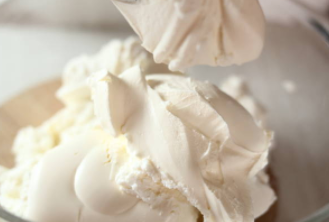Making your own cream cheese at home is easier than you might think. If you’ve ever wondered how much cream cheese you could make with just a few minutes of effort, this homemade cream cheese recipe is for you. Store bought cream cheese is convenient, but making your own gives you a rich and creamy texture, plus the satisfaction of knowing exactly what’s in your spread. With just a few ingredients and some basic kitchen tools, you can enjoy cream cheese that’s soft, fresh, and perfect for both sweet and savoury dishes.
Why Try a Homemade Cream Cheese Recipe?
Many people rely on store bought cream cheese for its convenience, but making cream cheese at home lets you control the fat content and flavour. Using whole milk and heavy cream, you can achieve a creamy consistency that’s ideal for spreading or using in your favourite recipes. Plus, you can add herbs or spices to create a savoury cream cheese that’s tailored to your taste.
Homemade Cream Cheese Recipe
Making your own cream cheese at home is a simple way to enjoy a fresh, creamy spread with ingredients you trust. This recipe is easy to follow and lets you customise the flavour and texture to suit your taste.
Ingredients and Equipment
Before you start, it’s important to gather everything you need. This section explains what ingredients work best and which tools will help you make cream cheese at home.
Ingredients
- 3.7 L whole milk (avoid ultra-pasteurised or UHT milk)
- 470 ml heavy cream (ultra-pasteurised is fine)
- ¼ teaspoon MA4001 Mesophilic Culture or Flora Danica
- 2 drops liquid rennet, mixed with 2 tablespoons cold water
- 1/8 teaspoon calcium chloride (if using pasteurised milk)
- 1 teaspoon salt
- Optional: fresh or dried herbs, spices
Equipment
- Large pot
- Thermometer
- Ladle or wooden spoon
- Large bowl and colander
- Butter muslin or cheesecloth
- Airtight container for storage
We offer all the equipment you need to make cream cheese at home, including cheese kettles and vats for consistent heating and curd handling tools for easy processing. Making your own cream cheese is a rewarding way to enjoy a rich and creamy texture in your favourite recipes.
Step-by-Step Instructions
This section walks you through each stage of making cream cheese, from preparing the milk to storing the finished product. You’ll see how easy it is to make a soft, spreadable cheese at home.
- Pour the whole milk and heavy cream into your pot. Warm the mixture over medium high heat until it reaches 23.8°C, using your thermometer for accuracy.
- Take the pot off the heat. If you’re using pasteurised milk, add calcium chloride and stir gently.
- Sprinkle the mesophilic culture over the milk. Let it sit for 2–3 minutes, then stir gently to blend.
- Add the rennet mixture and stir with an up-and-down motion for about a minute.
- Cover the pot and let the curd mixture set at room temperature (21–23°C) for 14–16 hours. The milk will form curds and separate from the yellowish liquid, which is the whey.
- After the resting period, you’ll notice thick curdles similar to yoghurt, with liquid whey visible.
- Line your colander with butter muslin or cheesecloth and set it over a large bowl to catch the remaining liquid.
- Gently ladle the cheese curds into the lined colander.
- Gather the sides of the muslin and tie them securely.
- Hang the bundle over the bowl and let it drain for 6–12 hours, depending on your desired consistency. Less time gives you a softer, more spreadable cream cheese; more time results in a firmer texture.
- Transfer the soft homemade cream cheese to a bowl. Add salt and, if you like, mix in fresh herbs, roasted garlic, or spices for a savoury twist.
- Store your cream cheese in an airtight container in the refrigerator. Enjoy cream cheese within a week for the best flavour and creamy texture.
Tips for the Best Homemade Cream Cheese
- For a lactose free milk option, you can substitute lactose free or reduced fat milk, though the texture may be slightly different.
- If you want a tangier flavour, try adding a splash of lemon juice or lime juice during the process.
- To make your cream cheese totally smooth, use a food processor after draining.
- If you have leftover liquid whey, you can use it in other recipes or discard it.
- For a firmer cheese, let it drain longer; for a softer, more spreadable cream cheese, shorten the draining time.
Storing and Using Your Cream Cheese
Keep your homemade cream cheese in an airtight container in the fridge. You can freeze cream cheese, but the texture may change slightly after thawing. Use your cream cheese as a spread, in savoury dishes, or even as a base for cheesecake and other desserts. If you like, add herbs, garlic powder, or even a swirl of sour cream for extra flavour.
Ready to Make Cream Cheese at Home?
We offer all the equipment you need to make cream cheese at home, from cheese kettles and vats to muslin cloths and thermometers. Making your own cream cheese is a rewarding way to enjoy a rich and creamy texture in your favourite recipes.







